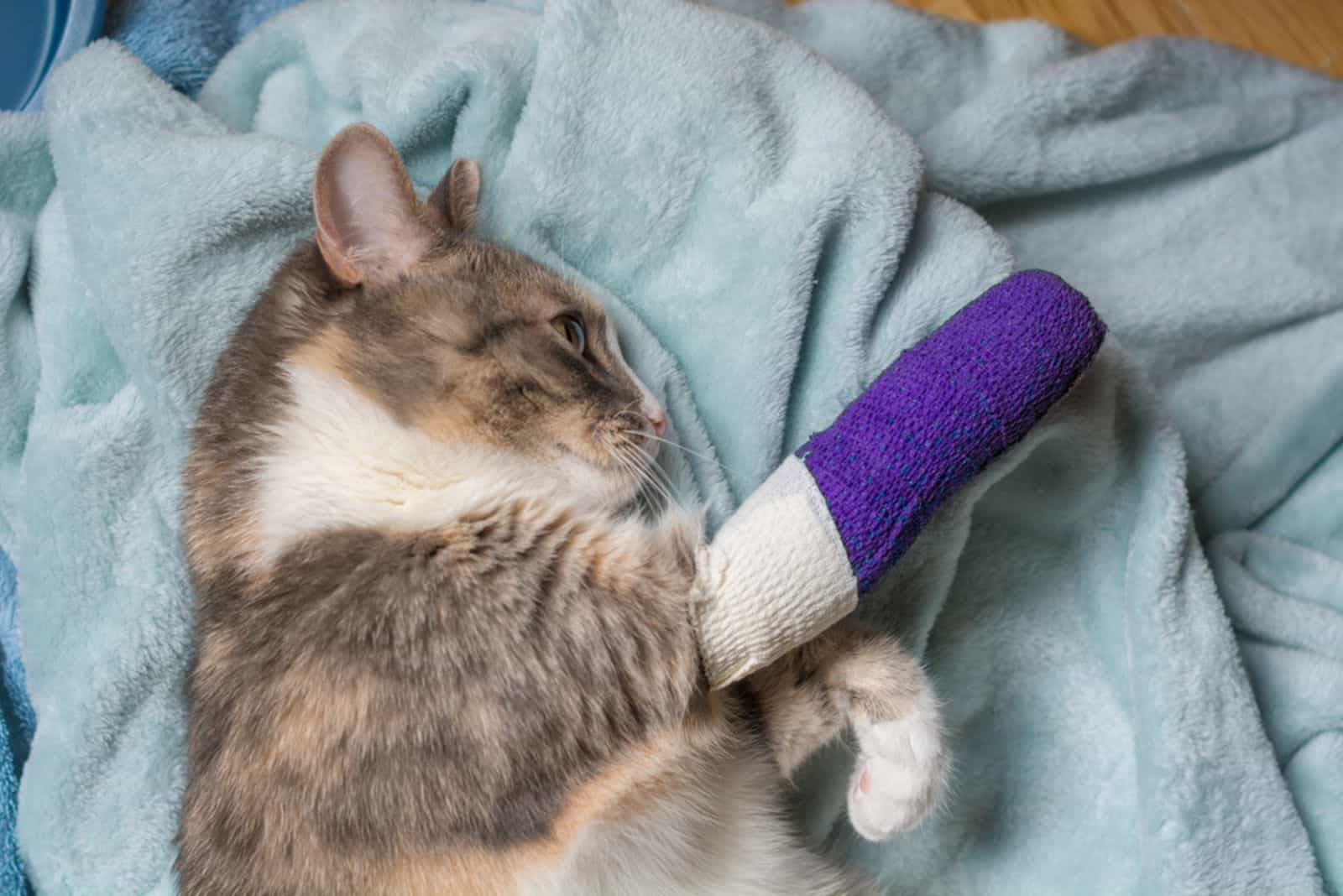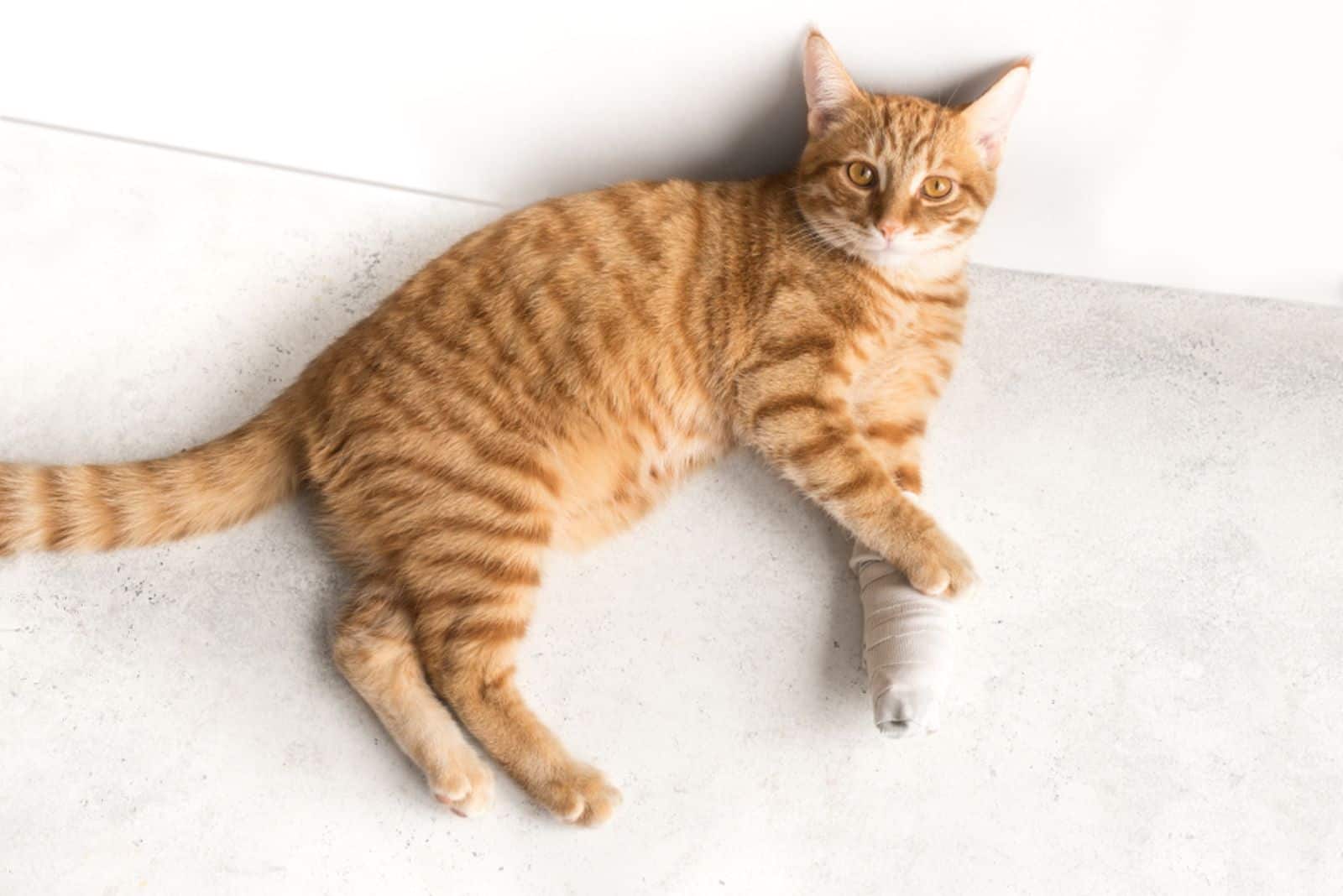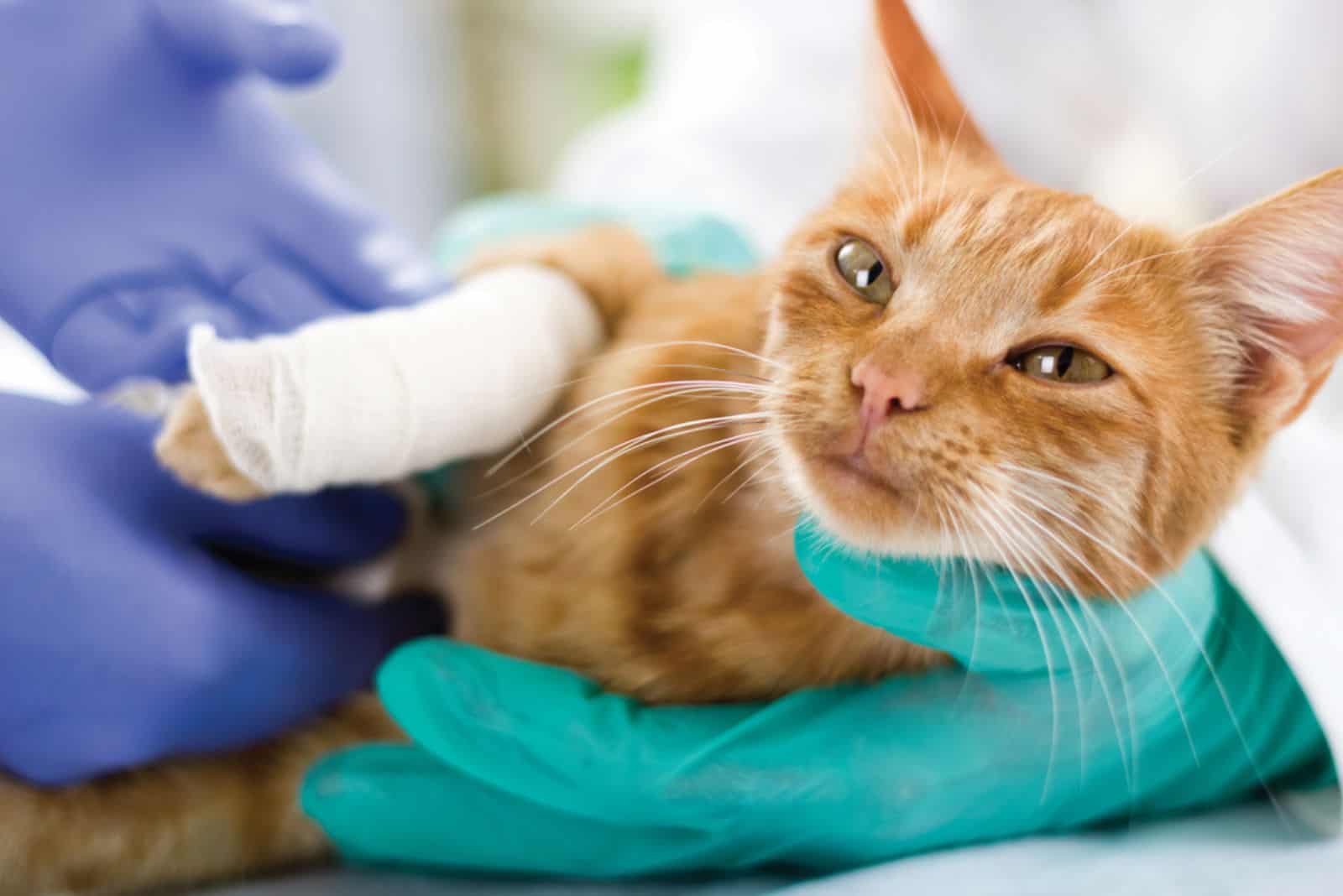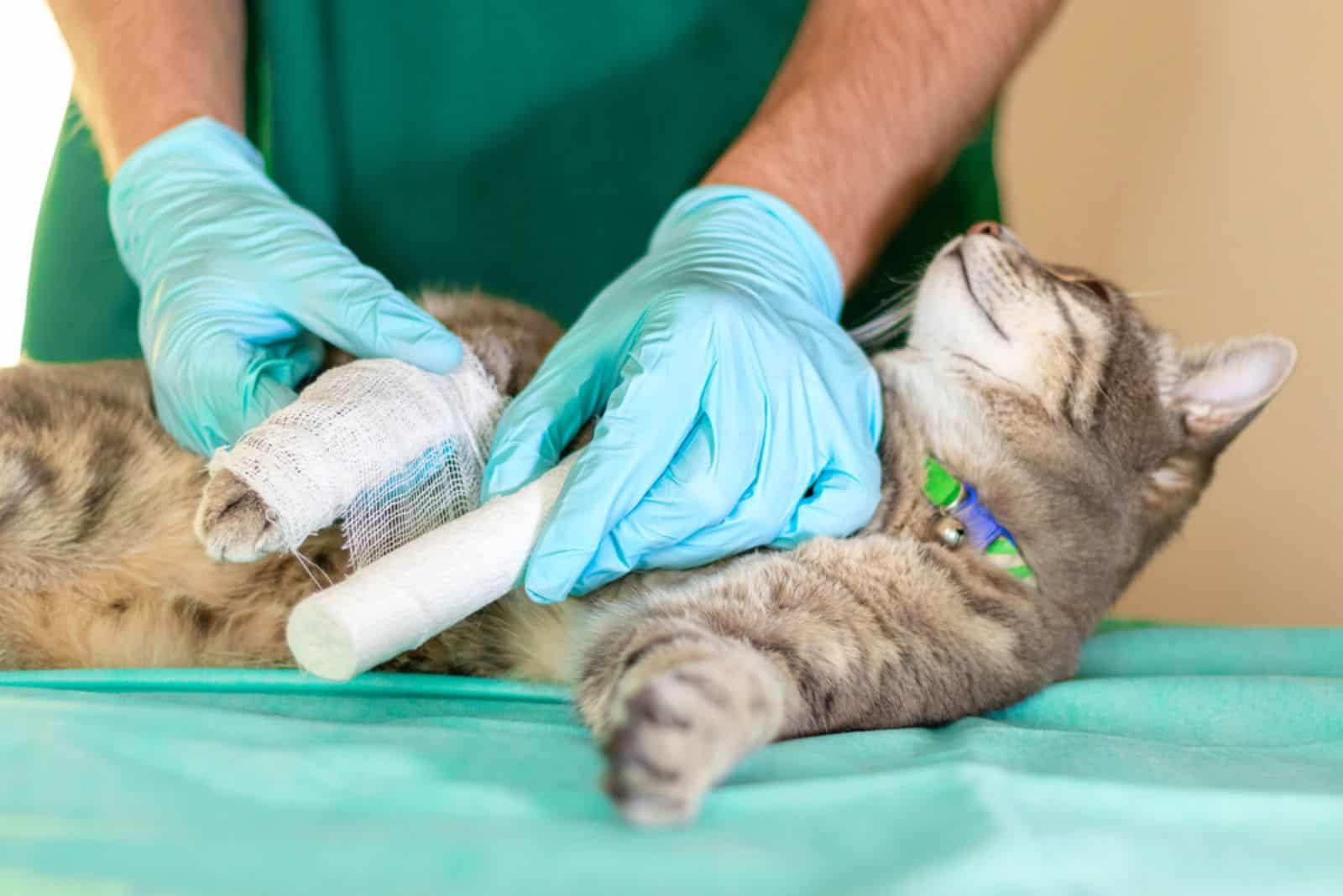Has Your Cat Broken A Leg? What Every Cat Owner Should Know

Cats are remarkable animals and all pet owners will know they typically have high activity levels.
That means that they love jumping, running, climbing, and similar. However, even though cats are very skilled, these activities do increase the risk of different accidents, such as fractures.
One of the most frequent fractures seen in cats is broken legs. Unfortunately, if a cat has broken its leg, there’s nothing much you can do at home, as it requires urgent professional help.
All you can do for a cat with broken leg, is to take them to the vet and take good care of them during the recovery period.
If you want to learn more about this topic, such as what are the signs of a cat’s broken leg, what are the common causes for leg fractures in cats and what treatments does this issue require, just keep reading and discover how you can help your feline friend!
Has Your Cat Got A Broken Leg?

Leg fractures in cats may range from minor injuries to more serious fractures. If a cat has a minor leg fracture it may not be obvious that the cat has a broken leg.
Whether it’s a minor or severe injury, this condition requires detailed examination and professional treatment, so it’s highly important for you to know how to recognize a cat with broken leg.
So, if you are wondering how to tell if a cat has a broken leg, worry not because this article provides you with several signs of a cat’s broken leg as well as with instructions on what to do next!
Signs That Your Feline Has Broken A Leg
Here are some signs that your cat’s leg is broken:
• Limping – Cats may exhibit symptoms like limping if they have untreated fractured legs. In severe fractures, cats will usually refuse to put weight on the broken leg as it’s so painful. In this case,the limb may dangle or drag as they walk.
However, in minor fractures, they may put some weight on the limb, but changes to how they walk will still be noticeable.
• Swollen area – In some circumstances, swelling and injury to the skin may also alert you to a broken leg. Large swellings, an abnormal limb angle, and blood or discoloration at the injury site can all be telltale signs.
An “open” fracture is one where the skin has been damaged close to the injury, which, if untreated, can result in infections.
• Wounds – In some fractures, wounds are easily noticed; an obvious sign that a cat has issues with its leg and requires immediate help.
• Loud meowing and hissing – Cat behaviors such as loud meowing and hissing are common signs of a cat that has experienced some kind of trauma.
Cats in pain often feel frightened because they’re vulnerable, therefore they may warn you not to touch them by hissing and loud meowing. This behavior is more frequent in stray cats as they are less likely to trust people.
• Biting you suddenly – Grabbing you and then biting you is common for injured cats and they display that behavior in order to defend themselves. Therefore, if you’re trying to rescue an injured cat, make sure you wear protective clothes and gloves.
• Increased hiding behavior – If it were a competition, cats would win when it comes to hiding pain. Injured cats tend to hide more often; usually until they heal. They know that they’re vulnerable and they don’t want others to know that or to risk being attacked.
This is the main reason why injured cats often hide. It’s easy when your cat hides in your home, but it is much more difficult with outdoor cats because you can’t be sure how long they will stay hidden.
• Loss of appetite – most cats with broken bones or other injuries have a decreased appetite, which eventually leads to weight loss. You need to make sure that the cat stays hydrated and seek veterinary attention.
The Most Common Causes Of Leg Fractures In Cats

There are a lot of things that can result in a cat’s broken leg. However, in this case, the most common causes of leg fractures in cats may be divided in two categories: traumatic and non-traumatic…
Traumatic Causes
• Falling from heights – cats love climbing and jumping around, and they’re very talented. In addition, most of the time cats land on their paws. However, in some situations, injuries such as leg fractures or sprains may occur due to a bad landing, or falling from a height.
• Vehicular trauma – this type of trauma includes external, visible injuries such as fractures, wounds, dislocation of the bones, lameness, and similar.
Sometimes, a cat may have internal injuries that aren’t visible on the outside. For this reason, it’s always a good choice to take the cat for an examination.
• Household injuries – your feline friend is safer indoors than outdoors, but still, it’s not completely safe because even indoor cats like to explore. Unfortunately, that sometimes leads to limb fractures in cats by getting injured on different household objects and furniture.
• Bites – in some cases, especially for outdoor cats, fractures can occur as a result of animal attacks and bites, such as a dog attack.
Besides possible fractures, this usually results in open wounds that require immediate veterinary care in order to prevent different infections from setting in.
• Other traumatic reasons – other reasons for broken extremities may include, arrows, bullets, accidents, and attacks which may easily result in a cat’s broken leg.
Non-traumatic Causes

Some of the non-traumatic things that may be the cause for limb fractures include the following:
• Infection – some infections may attack the cat’s bones, such as limbs, or joint integrity. This can cause a fracture in the affected limb.
• Bad diet – a cat’s diet is very important for its overall health. If a cat doesn’t receive enough of the necessary nutrients, this may weaken its bones and increase the risk of simple fractures.
• Disease – health conditions such as arthritis, obesity, diabetes, joint problems, and similar may weaken the bones and lead to bone fractures in the cat’s leg.
• Tumors – cancerous bones are very serious in felines and may result in a number of cat leg injuries including fractures.
• Parathyroid disorders – these disorders affect the hormone that regulates minerals in cats. When minerals such as vitamin D, calcium, and phosphorus decrease, this often results in bone abnormalities and a higher risk of fractures.
It’s also very important to know what to do after stepping on a cat’s tail!
What To Do If Your Cat Has Broken Its Leg
If you think your cat broke its front leg or back leg, the most important thing to do is to take the cat to the emergency vet clinic. Fractures always require special veterinarian attention, and it’s not something you can fix on your own.
The vet will know how to deal with the fracture and what to do, because fractures are commonly encountered in veterinary medicine. After the vet examines your feline friend, he’ll come up with a treatment plan based on the severity of the cat’s condition.
So, keep reading and find out how to help a cat with a broken leg!
Also, check out if it’s possible that Prednisone Killed Your Cat!
Treatment Options For A Cat’s Broken Leg

Although a cat’s broken leg may appear easy to diagnose, the vet still needs to determine the severity of the problem through a detailed examination.
This usually involves giving the cat sedation and doing an X-ray. Accurate results can only be obtained after anesthesia and an X-ray.
The importance of X-ray is to determine the exact location of the fracture so that the treatment of the cat’s injury can be planned.
Fractures may be either simple or comminuted. Simple fractures are a single break while comminuted refers to fractures where there are several pieces of bones.
Moreover, there are two different types of fractures:
• Nondisplaced – the bones usually heal themselves.
• Displaced – more serious fractures that usually require surgery.
Your pet’s treatment will depend on the severity of the fracture and whether it is an open or closed one.
Treating a cat’s broken leg may include:
• Cage rest – if a cat has a minor leg fracture, the vet usually recommends cage rest, in order to limit the cat’s movement so that the leg can heal itself quickly.
The vet may use splints and bandages and prescribe anti-inflammatory pain medications to help the cat get through the recovery process more easily.
• Surgery – in more serious fractures, the vet will suggest surgery to fix the cat’s broken leg. Recovery after surgery may take a bit longer but the cat will be given pain relief medications such as Gabapentin so that it will not feel a lot of pain.
• Amputation – in severe fractures, the veterinary surgeon may suggest amputation of the limb This will be difficult news to receive, but sometimes it’s the best option for your feline friend and in some cases it is the only option to save its life.
During the surgery, the cat is under anesthesia so they don’t feel anything during the process.
It’s normal that recovery after the amputation lasts a bit longer, however, you’ll see your cat walking again quite quickly because they typically adapt to a “new life” very quickly.
Find out what you should do if you notice your cat’s legs are bent.
Recovery Guide For Cats With A Broken Leg

The healing time for a cat’s broken leg also depends on the severity of the limb fracture.
However, you won’t be alone as the vet will provide you with all the necessary instructions that you need to follow up for proper cat care.
Besides that, further vet-checks are also important.
The most important part of home care is to limit your cat’s activities so that the leg can heal faster.
The best thing is to isolate the cat in a safe, warm, and calm environment. Don’t forget to provide them with water, food, a litter box, and other essentials.
Make sure you secure the room so that the cat cannot injure itself again. For peace of mind, you can provide the cat with a larger cage, where it can stay during the night.
Cats are more active during dusk and dawn so, this way, you’ll reduce the risk of further injury.
Another important thing in the cat’s aftercare is their diet. You should provide your feline friend with good, nutritional food in order to improve their immune system and support the healing process.
Feed your kitty with top-quality food that’s high in calcium and phosphorus which are important for healing broken bones. Healthy treats will help reinforce the bond between you if your cat is traumatized as a result of its experiences.
Final Thoughts
Limb fractures can be very serious; it’s crucial that every pet owner is able to recognize a cat with broken leg.
Cats will usually show some of the following symptoms: loud meowing, hissing, loss of appetite, weight loss, limping, biting, hiding, and similar.
If you think you have a cat with broken leg, in most cases, first aid is not helpful. Instead, you should carefully pick up your feline and take her to the emergency vet clinic as soon as possible.
After a thorough examination, and depending on the severity of the injury to the cat’s broken leg, the vet will make a treatment plan that they will follow to give your cat the best chance of healing.
Treatments of fractures may include rest, surgery, or even amputation in severe cases. With the appropriate treatment, a balanced diet, and good home care, your kitty will be back on its paws sooner than you think!






